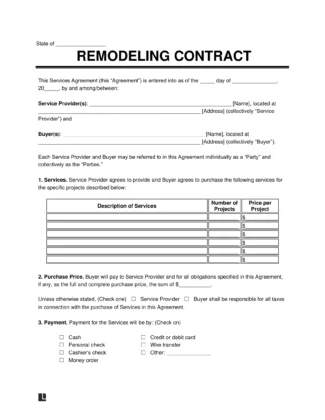
Document the details of a remodeling job using a contract, ensuring both parties are aware of what to expect.

Updated July 10, 2024
Written by Sara Hostelley | Reviewed by Brooke Davis
A remodeling contract is a legally binding agreement between a homeowner (or property owner) and a contractor who will perform home improvement services. These services can include any renovation, repair, or construction project for an existing residence.
Remodeling contracts safeguard your rights when remodeling a client’s home or property. They contain essential legal provisions that protect you from liability and establish clear guidelines with your customers.
Remodeling is the process of making significant alterations to an existing building or structure. The transformation that results from remodeling improves a space’s aesthetics and/or functionality. Remodeling may involve enlarging existing rooms, adding or removing walls, or overhauling a room’s layout.
Some specific examples of remodeling projects include the following:
Whether performing a small job or major construction, writing a remodeling agreement will provide the following benefits:
While each remodeling job has unique considerations, you can explore a general overview of the stages within the remodeling process:
The first stage involves a meeting between the independent contractor and the client. The client will share their needs and preferences, and the contractor will provide their input to ensure the client’s ideas are realistic.
The independent contractor may also collaborate with a designer or architect to develop a feasible plan and ensure that they adhere to building codes.
It depends. Each jurisdiction has different guidelines when determining whether a contractor needs a building permit. It’s advisable to check with your city or county’s building and permits department.
A general rule of thumb is that more extensive changes that can present issues with structural integrity will require a building permit. For example, modifying load-bearing walls or changing a home’s floor plan will require a permit in most instances.
Depending on the project’s scope, the contractor may have to perform demolition to remove existing fixtures, walls, and structures. This demolition helps them make space for replacements or modifications. Once they demolish the appropriate elements, they can prepare the space to begin the client’s desired work.
Structural work refers to modifying the building’s structures. For example, the contractor may perform foundation, roofing, or framing work to accommodate the new design or layout.
Mechanical work refers to the installation or repair of a structure’s mechanical systems. It may involve upgrading or rerouting electrical wiring, fire protection systems, HVAC systems, and plumbing systems.
At this point in the remodeling process, the contractor installs new fixtures and finishes to increase the space’s practical elements and decorative appeal. For example, they may install new flooring, lighting fixtures, appliances, countertops, and cabinets.
The contractor applies wallpaper or paint and other finishing touches to the surfaces and walls to complete the space’s aesthetics.
Depending on the regulations in your area, the space may have to undergo inspections at different stages of the remodeling project. This way, inspectors can ensure that the contractor complies with safety standards and building codes.
Once the contractor receives final approval from local inspectors, they can issue an invoice for their work and present the finished product to the property owner.
There are specific vital provisions you should include in your remodel contract. These include the following:
Download a free remodeling contract template in PDF or Word format below: